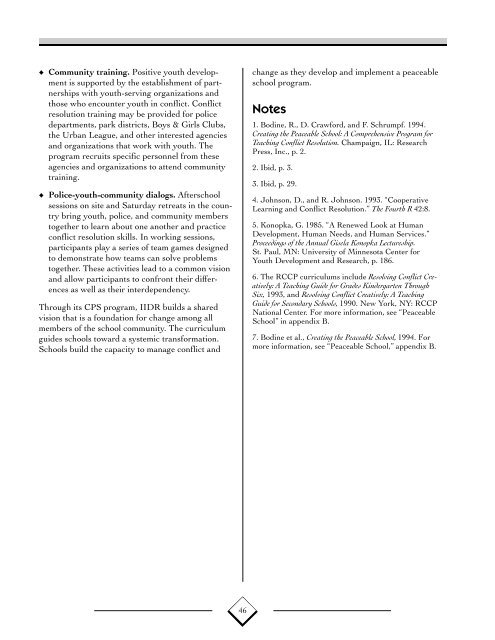Conflict Resolution Education - National Criminal Justice Reference ...
Conflict Resolution Education - National Criminal Justice Reference ...
Conflict Resolution Education - National Criminal Justice Reference ...
Create successful ePaper yourself
Turn your PDF publications into a flip-book with our unique Google optimized e-Paper software.
♦ Community training. Positive youth development<br />
is supported by the establishment of partnerships<br />
with youth-serving organizations and<br />
those who encounter youth in conflict. <strong>Conflict</strong><br />
resolution training may be provided for police<br />
departments, park districts, Boys & Girls Clubs,<br />
the Urban League, and other interested agencies<br />
and organizations that work with youth. The<br />
program recruits specific personnel from these<br />
agencies and organizations to attend community<br />
training.<br />
♦ Police-youth-community dialogs. Afterschool<br />
sessions on site and Saturday retreats in the country<br />
bring youth, police, and community members<br />
together to learn about one another and practice<br />
conflict resolution skills. In working sessions,<br />
participants play a series of team games designed<br />
to demonstrate how teams can solve problems<br />
together. These activities lead to a common vision<br />
and allow participants to confront their differences<br />
as well as their interdependency.<br />
Through its CPS program, IIDR builds a shared<br />
vision that is a foundation for change among all<br />
members of the school community. The curriculum<br />
guides schools toward a systemic transformation.<br />
Schools build the capacity to manage conflict and<br />
46<br />
change as they develop and implement a peaceable<br />
school program.<br />
Notes<br />
1. Bodine, R., D. Crawford, and F. Schrumpf. 1994.<br />
Creating the Peaceable School: A Comprehensive Program for<br />
Teaching <strong>Conflict</strong> <strong>Resolution</strong>. Champaign, IL: Research<br />
Press, Inc., p. 2.<br />
2. Ibid, p. 3.<br />
3. Ibid, p. 29.<br />
4. Johnson, D., and R. Johnson. 1993. “Cooperative<br />
Learning and <strong>Conflict</strong> <strong>Resolution</strong>.” The Fourth R 42:8.<br />
5. Konopka, G. 1985. “A Renewed Look at Human<br />
Development, Human Needs, and Human Services.”<br />
Proceedings of the Annual Gisela Konopka Lectureship.<br />
St. Paul, MN: University of Minnesota Center for<br />
Youth Development and Research, p. 186.<br />
6. The RCCP curriculums include Resolving <strong>Conflict</strong> Creatively:<br />
A Teaching Guide for Grades Kindergarten Through<br />
Six, 1993, and Resolving <strong>Conflict</strong> Creatively: A Teaching<br />
Guide for Secondary Schools, 1990. New York, NY: RCCP<br />
<strong>National</strong> Center. For more information, see “Peaceable<br />
School” in appendix B.<br />
7. Bodine et al., Creating the Peaceable School, 1994. For<br />
more information, see “Peaceable School,” appendix B.

















